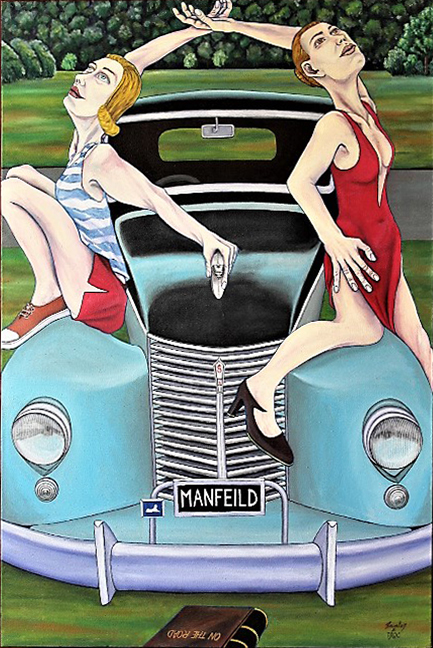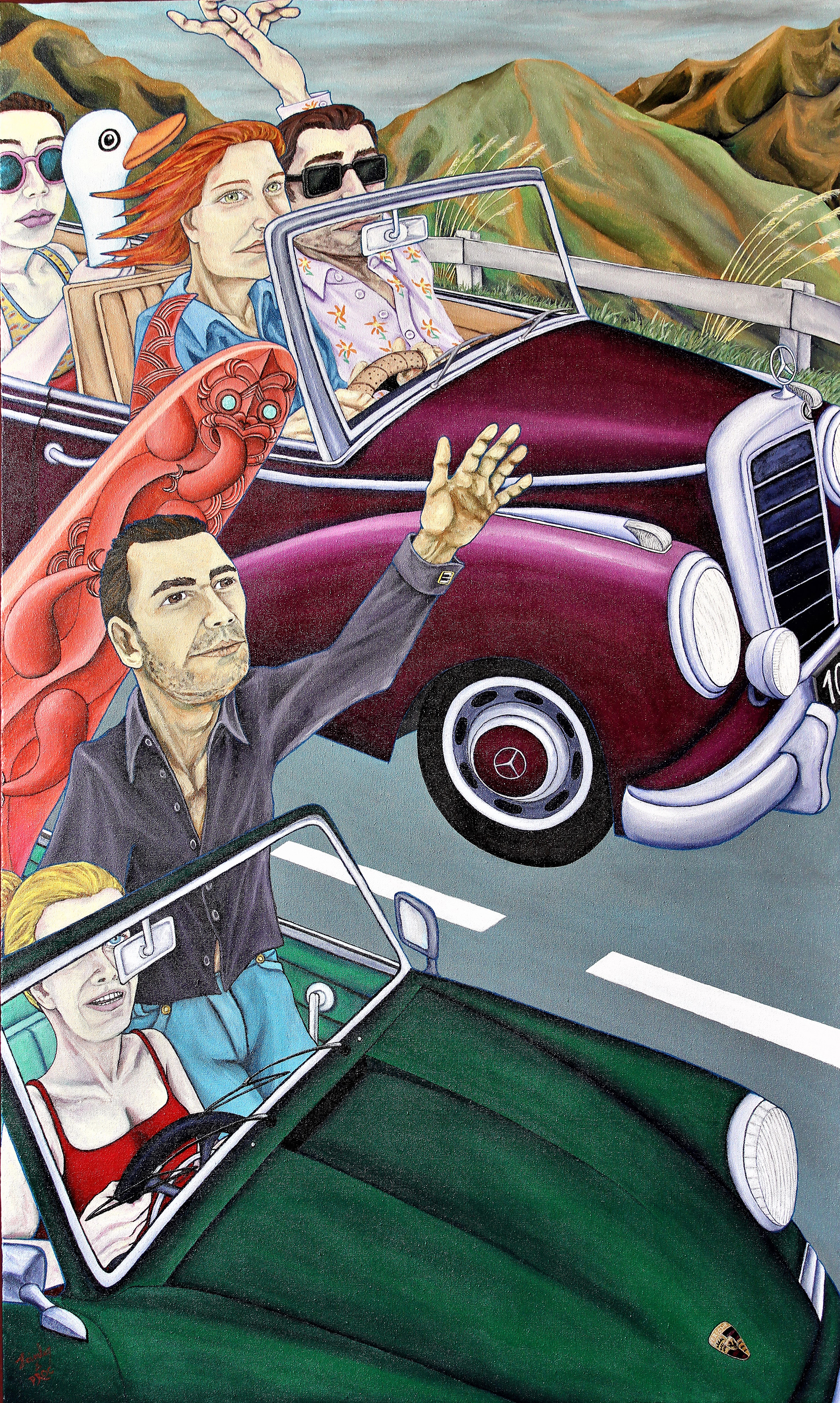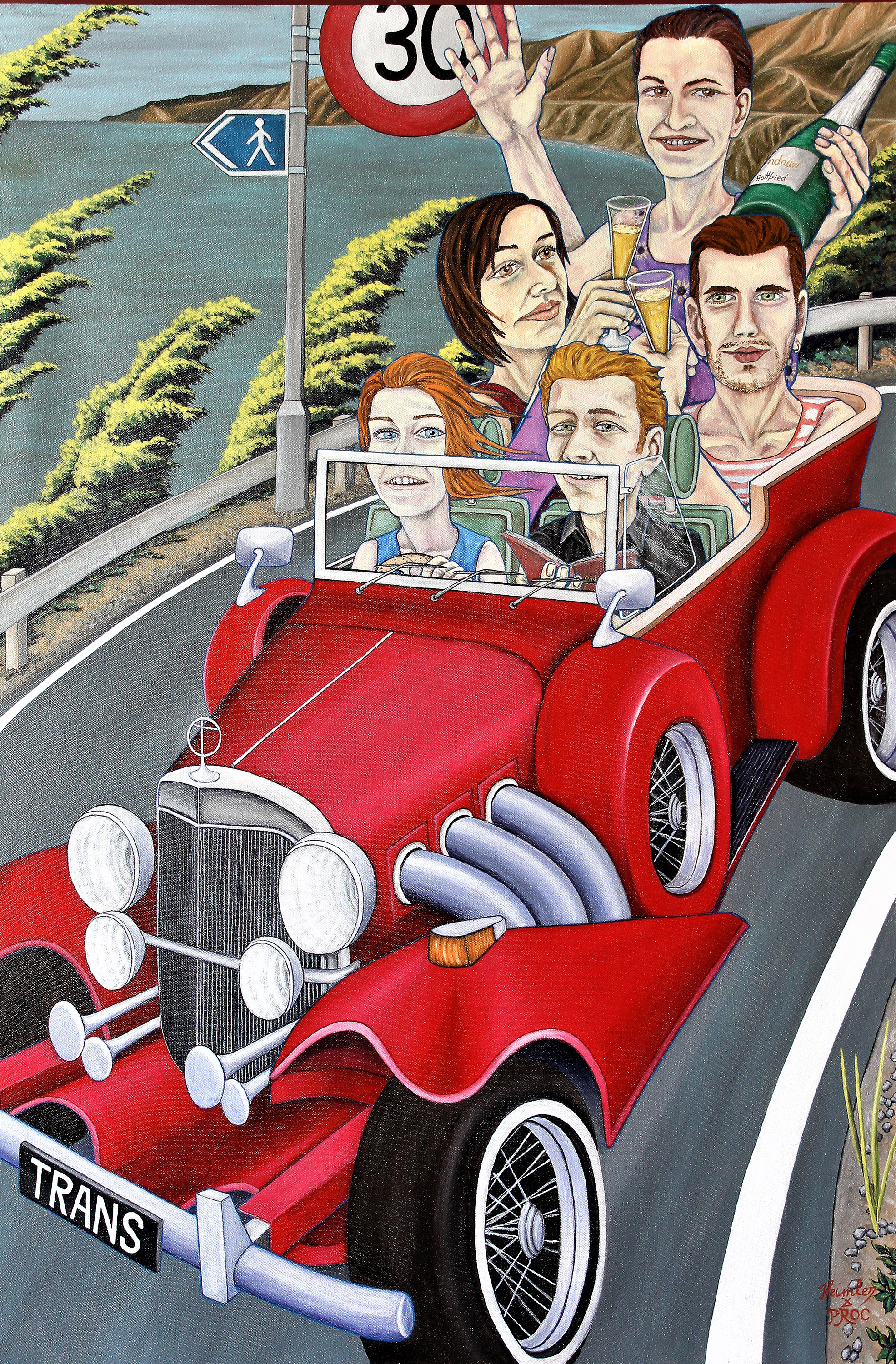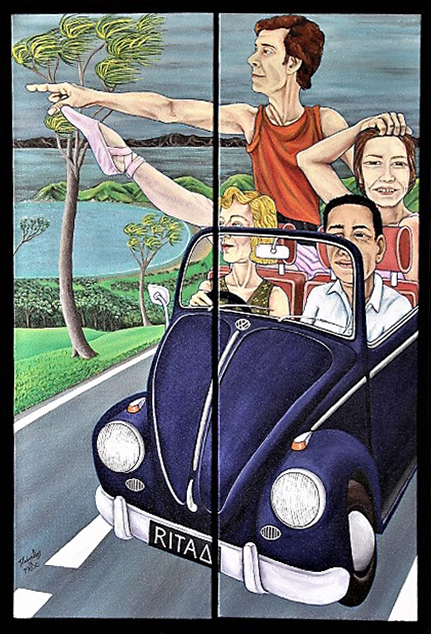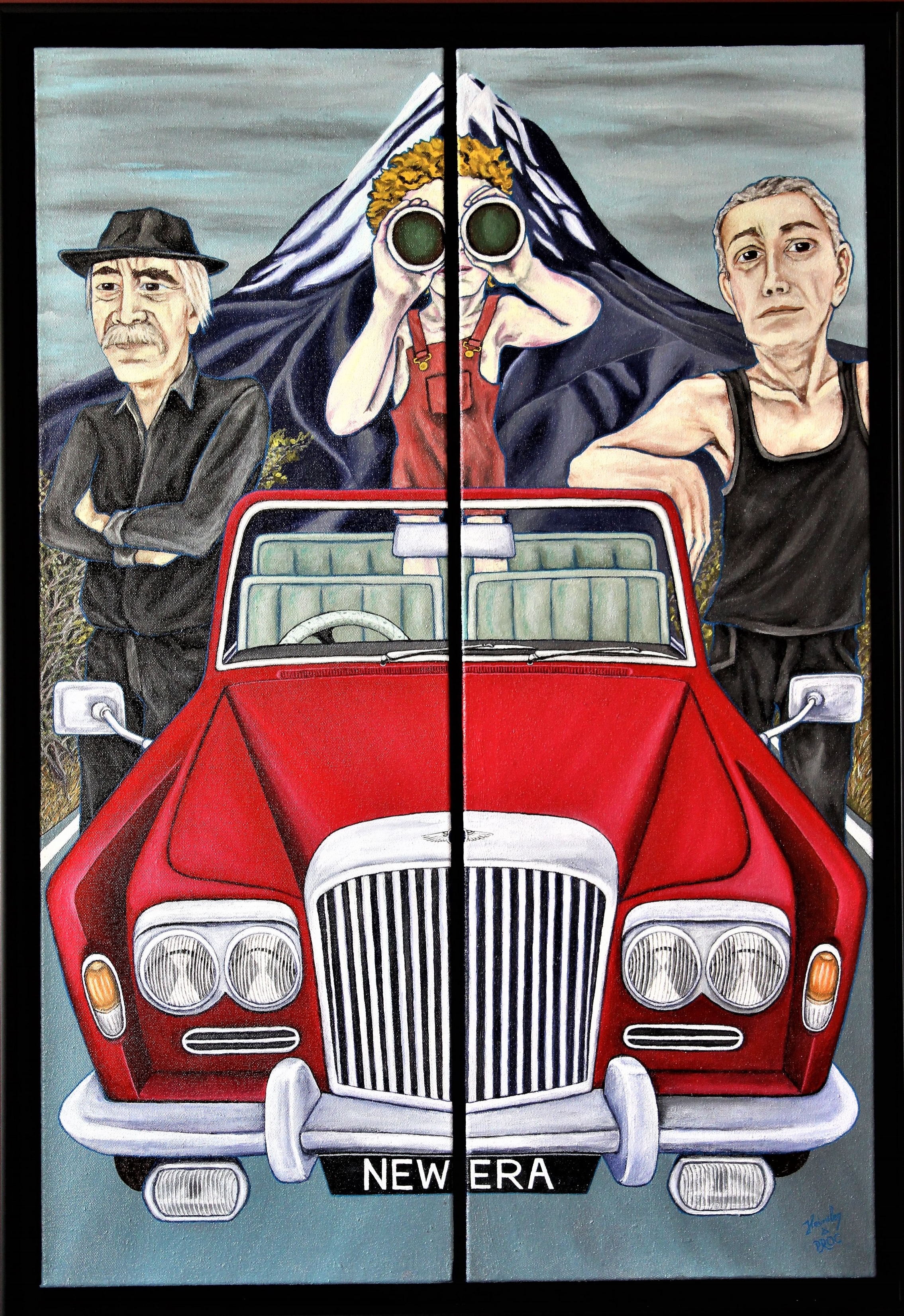Tribute to Lempicka - Queen of ArtDeco
Kiwi Art House Gallery
22 March - 11 Avril 2025
Life Capsule (91 x 120cm) acrylic on canvas
FABULOUS DINNERS Exhibition
Kiwi Art House Gallery
3 - 24 May 2024
Pretenders (92 x93) acrylic on canvas
RETROSPECTIVE EXHIBITION
AI GALLERY AUCKLAND
16 - 30 March 2024
Fruits in your hand (122x124 cm) acrylic on canvas
FREE AS A BIRD Exhibition
hosted by YOYO DESIGN, WELLINGTON
14 July - 30 July 2021
Paradisiac (153 x 103cm) acrylic on canvas
THE HEDGE Exhibition
KIWI ART HOUSE GALLERY, WELLINGTON
28 October - 20 November 2020
Keep it Warm (105 x 105 cm) acrylic on canvas
GAUGUIN IN AOTEAROA Exhibition
McATEMNEY GALLERY, GERALDINE
15 February - 15 Mars 2020
Moa and Jack (90 x 60 cm) acrylic on canvas
PACIFIC MEMORIAL Exhibition
AI GALLERY, AUCKLAND
10 - 24 November 2019
Pacific Memorial (6 x 153cm x 102cm) acrylic on canvas
Transcendent Cultures and Global Encounters in Pacific Memorial
In Gabriel Heimler and Anna Proc’s Pacific Memorial, a massive polyptych consisting of six brightly painted panels, one is presented with a diverse array of figures posed or moving in various ways within an idyllic landscape. With such a broad spectrum of visual elements to contemplate, we are tempted to enjoy the luxury of focusing on each panel individually, randomly studying the individual or small groups of figures arranged against a bright landscape and sky. However, the horizontal orientation of the panels begs the viewer to contemplate the work as one might look at a Chinese painted handscroll, ceremoniously unrolled from right to left. As it turns out, this might be the most appropriate approach to take, as the work is meant to celebrate the inclusion of Chinese people and their cultural achievements and global influence in New Zealand and the Pacific region as a whole. Heimler and Proc’s role is to reveal this international encounter through the lens of Paul Gauguin, assuming Gauguin could travel forward in time and put aside some of his preconceived notions!
As we journey through the panoramic landscape before us, we are struck by an unexpected combination of figures and scenes: a range of individuals from differing cultures and time periods in contorted poses, actively moving through the space or calmly sitting; a stark male figure wearing a British bowler hat and lapel pin leering in the foreground; and a recreation of Édouard Manet’s Dejeuner Sur l’herbe, using sand in place of grass, and Gauguin and Vincent Van Gogh in place of Manet’s male family members, just to name a few. The figures found throughout the work are placed against a dazzling background of familiar flora and Wellington landmarks, with the colors of the red flowering New Zealand Christmas trees popping off the panels. The presence of carved manaia ancestral figures referencing Maori culture grace an elegant wooden gateway near the center of the work, as well as a canoe prow off to the right. The gateway directs our focus to the female figure clad in a yellow martial arts outfit, whose leg and hand project boldly forward through this spiritual, mana-filled portal.
A majority of the Chinese people encountered by Gauguin in 19th century Polynesia were probably traders and indentured laborers. As Gauguin’s interests were focused more on the local inhabitants of the communities where he resided and the pursuit of his artistic work, it is likely that his interactions with Chinese migrants were limited in scope. In retrospect, a broader understanding of the diversity of the different Chinese populations traveling throughout the region has shed enhanced light on the interesting make-up of these populations, how their influence was felt in the past, and how it continues to be felt today. In like fashion, discussions of Paul Gauguin’s time spent in Polynesia have often been focused, somewhat narrowly, on the negative, and it is not surprising to find that stories of Gauguin’s personal life sometimes overshadow his achievements as an artist. Through a deeper consideration of his travels and experiences living overseas, combined with his active study of art from other cultures, a more nuanced picture emerges: Gauguin developed a tremendous talent for rendering color and form in new and dynamic ways. This bold sensibility and approach to color, albeit shaped by European primitivism, nevertheless shook European art to the core, forever cementing Gauguin’s contributions to the history of art.
It is these references to global encounters that make Heimler and Proc’s work so powerful and thought-provoking. In the case of this work, viewers are encouraged to consider not only the historical legacy of colonialism and imperialism in the Pacific region, but also how the juxtaposition of many different cultures in today’s world is accelerated and enriched by global commerce, social media, and cultural interactions that would have been almost unheard of a century ago. The artists’ rendering of the beautiful Chinese women with knowing glances towards the left of the composition, for example, are not meant to be read as exotic objectifications – they transcend stereotypes to suggest individual women with a unique presence and strength, worldly in their own right. The primary lesson to be derived from Pacific Memorial is therefore multifaceted and complex. Heimler and Proc remind us that there are presently many lenses through which to view this global tapestry, and that we must remain open to all the possibilities. Indeed, we are much richer for the chance to glimpse into this world.
Alice R. Burmeister, Ph.D.
BEIJING INTERNATIONAL ART BIENNALE
AUGUST - SEPTEMBER 2019
New Era
Carved Surf
GAUGUIN IN AOTEAROA Exhibition
hosted by the EMBASSY OF HUNGARY
WELLINGTON
11 April - 21 May 2019
WAIRUA (SPIRIT) (102 x 153 cm) acrylic on canvas
RETROSPECTIVE Exhibition
KIWI ART HOUSE GALLERY
WELLINGTON
13 - 28 FEBRUARY 2019
YESTERDAY ( 61 x 46 cm) acrylic on canvas
DOUBLE BOND Exhibition
Organised by the Embassy of Hungary in Wellington
15 November - 20 December 2018
Buda Waka. Freedom Fighters (168 x 102 cm) acrylic on canvas
Freedom is a human longing, a hope. Eugène Delacroix personalised the notion of liberty in the form of a woman in his work, Liberty Leading the People. In the painting Buda Waka, Heimler and Proc use this incarnation in order to symbolise the desire for liberty, as expressed by Budapest's freedom fighters in 1956. Heimler and Proc combine Delacroix's Liberty, a hole in the Hungarian flag and a Maori waka to underscore the search for freedom that is ubiquitous in every population. Dr. László Zsolt Szabó, the first Ambassador of Hungary to New Zealand, is depicted in the painting as one of the waka paddlers to re-mind the viewer of his function to recall the timelessness and strength that has characterized Hungarian freedom fighters throughout history and across continents.
ON THE ROAD Exhibition
26 May - 15 June 2018
Location: Southwards Car Museum, Kapiti Coast
“The sun goes down long and red. All the magic names of the valley unrolled - Manteca, Madera, all the rest. Soon it got dusk, a grapy dusk, a purple dusk over tangerine groves and long melon field; the sun the color of pressed grapes, slashed with burgundy red, the fields the color of love and Spanish mysteries. I stuck my head out the window and took deep breaths of the fragant air. It was the most beautiful of all moments.”
― Jack Kerouac, On the Road
In his seminal work, On the Road, Jack Kerouac traveled the back roads of the vast United States. He felt the very heartbeat of the nation as he journeyed from one town to the next. He met men, women and children from all walks of life. He heard their secrets, looked inside their dreams. He ate, he drank, he smoked. He lived life fully, gloriously. He peered into the depths of men, and as he did so, he unearthed truths deep within his own soul.
In much the same way as Kerouac opened his heart and his mind, allowing the vastness of the country to fill him with wonderment, so too do Gabriel Heimler and Anna Proc embrace the people and places of New Zealand. Their lively depictions of New Zealand travelers burst with life and color. Heimler and Proc's whimsical characters come to life as they hit the road in their fanciful vintage automobiles. Characters leap of the canvas, cheerfully inviting the viewer to join them on their merry journeys.
"The sun goes down," Kerouac said, "long and red… Soon it got dusk, a grapy disk, a purple dusk over tangerine groves… The sun the color of pressed grapes, slashed with burgundy red, the fields the color of love and Spanish mysteries." (On the Road, 1957)
With his words, Kerouac splashes the page with vivid color, enlivens it with one-of-a-kind personalities. In their homage to ‘On the Road’, Heimler and Proc do much the same with their paintings, bringing to life the characters that Kerouac envisioned. The written and the painted compliment one another beautifully, and when the two come together, the effect is nothing short of magical.
Shooting Star (153 x 102 cm)
Island Sound (60 x 50 cm)
Tamara Lempicka’s painting Tamara in a Green Bugatti (1929) is one of her most famous paintings and also her auto-portrait as a driver. "This showed her at the wheel of a Bugatti racing car wearing a leather helmet and gloves and wrapped in a grey scarf, a portrait of cold beauty, independence, wealth, and inaccessibility" (Foxhall 1987). We recognised the historical connection between this painting and our idea for the series ‘On the Road’. It inspired us to work on Island Sound, which became the first of our 'On the Road' series. We used this painting’s construction and developed a New Zealand context. We inserted a stylish woman, her pet dog next to her and Jane Campion’s landscape. The dog has an ear lifted up as if it is hearing something coming from the sea or from the island. The dog works as a link between the landscape and the woman.
Manfeild (153 x 102 cm)
A direct inspiration for the exhibition, the cult book of writer Jack Kerouac, representative of so-called Beat Generation. The picture goes even further by suggesting New Zealand writer Katharine Mansfield in a scenario of female empowerment, with a message of tolerance and transformation that is repeated in the painting entitled Trans.
Carved Surf (169 x 100 cm)
Through a surfboard carved with Maori motifs, Heimler & Proc pay tribute to one of the most representative works of the artist Michael Parekowhai. The complelling painting fosters a sense conversation between the automobiles and their distinguished occupants, human and birds included.
Trans (153 x 102 cm)
In the exhibition ‘On the Road’, the painting Trans is the guardian of change, of evolution. The characters in the canvas celebrate their own individuality while decidedly sharing their experiences and embarking on a journey through the anchoritic New Zealand. Thus, each subject performs an exercise of introspective exploration, discovering and accepting itself, as it travels through the indomitable Kapiti Coast, aboard a vehicle that becomes synonymous with renewal in this world where modernity demands diversity, inclusion and tolerance. Trans is therefore an ode to the permanent transformation of everything that makes us human.
Rita (127 x 88 cm)
In a colorful interplay of professional camaraderie, the renowned painter Rita Angus accompanies metaphorically a group of young people in the painting that bears her name. In this manner, artistic expressions are honored and the search for a personal and unrepeatable identity is furthered.
New Era (127 x 88 cm)
The works discussed above lead us to the painting entitled New Era, a balanced composition where the artist Ralph Hotere shelters a new generation that looks to the future with energy. Behind him, Mount Taranaki emerges, synonymous of strength and Maori oral tradition.
Seatoun (127 x 88 cm)
In the work entitled Seatoun, the famous painter Michael Smither ventures deeply into New Zealand territory. He sits at the wheel of a collectable vehicle, surrounded by a very local landscape and allusions to the rural and urban worlds that coincide in Aotearoa.
Jaguar's Hunt (153 x 102 cm)
The iconic and artistic references continue in the rest of the works of ‘On the Road’, including the avant-garde New Zealand poet Sam Hunt, who is seen driving a classic vehicle. He offers a friendly greeting to a fellow driver who responds with indifference. The interaction is symbolic of the encounters and disagreements between the different sectors of modern societies.
Shooting Star (153 x 102 cm)
‘On the Road’ concludes with a message for all of us, illustrated in the painting of the two lovers who look out from their vehicle at a car with dark windows and incognito occupants. The scene hints at an unknown forthcoming, but one that is full of possibilities. On this road through New Zealand that Heimler and Proc have invited us to travel, to enjoy and to admire, we will be the architects of our own our conversations, our own stories.













